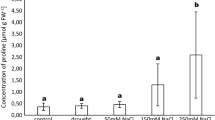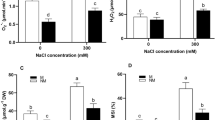Abstract
In order to characterise the effect of ectomycorrhiza on Na+-responses of the salt-sensitive poplar hybrid Populus × canescens, growth and stress responses of Paxillus involutus (strain MAJ) were tested in liquid cultures in the presence of 20 to 500 mM NaCl, and the effects of mycorrhization on mineral nutrient accumulation and oxidative stress were characterised in mycorrhizal and non-mycorrhizal poplar seedlings exposed to 150 mM NaCl. Paxillus involutus was salt tolerant, showing biomass increases in media containing up to 500 mM NaCl after 4 weeks growth. Mycorrhizal mantle formation on poplar roots was not affected by 150 mM NaCl. Whole plant performance was positively affected by the fungus because total biomass was greater and leaves accumulated less Na+ than non-mycorrhizal plants. Energy dispersive X-ray microanalysis using transmission electron microscopy analysis of the influence of mycorrhization on the subcellular localisation of Na+ and Cl− in roots showed that the hyphal mantle did not diminish salt accumulation in root cell walls, indicating that mycorrhization did not provide a physical barrier against excess salinity. In the absence of salt stress, mycorrhizal poplar roots contained higher Na+ and Cl− concentrations than non-mycorrhizal poplar roots. Paxillus involutus hyphae produced H2O2 in the mantle but not in the Hartig net or in pure culture. Salt exposure resulted in H2O2 formation in cortical cells of both non-mycorrhizal and mycorrhizal poplar and stimulated peroxidase but not superoxide dismutase activities. This shows that mature ectomycorrhiza was unable to suppress salt-induced oxidative stress. Element analyses suggest that improved performance of mycorrhizal poplar under salt stress may result from diminished xylem loading of Na+ and increased supply with K+.









Similar content being viewed by others
References
Al-Karki GN (2000) Growth of mycorrhizal tomato and mineral acquisition under salt stress. Mycorrhiza 10:51–54
Alvarez ME, Pennell RI, Meijer PJ, Ishikawa A, Dixon RA, Lamb C (1998) Reactive oxygen intermediates mediate a systemic signal network in the establishment of plant immunity. Cell 92:773–784
Asghari HR, Marschner P, Smith SE, Smith FA (2005) Growth response of Atriplex nummularia to inoculation with arbuscular mycorrhizal fungi at different salinity levels. Plant Soil 273:245–256
Baum C, Makeschin F (2000) Effects of nitrogen and phosphorus on mycorrhizal formation of two poplar clones (Populus trichocarpa and P. tremula x tremuloides). J Plant Nutr Soil Sci 163:491–497
Bois G, Bertrand A, Piché Y, Fung M, Khasa DP (2006) Growth, compatible solute and salt accumulation of five mycorrhizal fungal species grown over a range of NaCl concentrations. Mycorrhiza 16:99–109
Bolu WO, Polle A (2004) Growth and stress reactions in roots and shoots of a salt-sensitive poplar species (Populus x canescens). Trop Ecol 45:161–171
Chen DM, Ellul S, Herdman K, Cairney JWG (2001) Influence of salinity on biomass production by Australian Pisolithus spp. isolates. Mycorrhiza 11:231–236
Cripps CL, Miller OK (1993) Ectomycorrhizal fungi associated with aspen on three sites in the north-central Rocky Mountains. Can J Bot 71:1414–1420
Feng G, Zhang FS, Li XL, Tian CY, Tang C, Rengel Z (2002) Improved tolerance of maize plants to salt stress by arbuscular mycorrhiza is related to higher accumulation of soluble sugars in roots. Mycorrhiza 12:185–190
Fritz E (1989) X-ray microanalysis of diffusible elements in plant cells after freeze-drying, pressure-infiltration with ether and embedding in plastic. Scanning Microsc 3:517–526
Fritz E, Jentschke G (1994) Agar standards for quantitative X-ray microanalysis of resin-embedded plant tissues. J Microsc 174:47–50
Gafur A, Schützendübel A, Langenfeld-Heyser R, Fritz E, Polle A (2004) Compatible and incompatible Paxillus involutus isolates for ectomycorrhization in vitro with poplar (Populus x canescens) differ in H2O2 production. Plant Biol 6:91–99
Ghorbanli M, Ebrahimzadeh H, Sharifi M (2004) Effects of NaCl and mycorrhizal fungi on antioxidative enzymes in soybean. Biol Plant 48:575–581
Gianinazzi-Pearson V, Dumas-Gaudot E, Gollotte A, Tahiri-Alaoui A, Gianinazzi S (1996) Cellular and molecular defence-related root responses to invasion by arbuscular mycorrhizal fungi. New Phytol 133:45–57
Giri B, Mukerji KG (2004) Mycorrhizal inoculant alleviates salt stress in Sesbania aegyptiaca and Sesbania grandiflora under field conditions: evidence for reduced sodium and improved magnesium uptake. Mycorrhiza 14:307–312
Giri B, Kapoor R, Mukerji KG (2003) Influence of arbuscular mycorrhizal fungi and salinity on growth, biomass, and mineral nutrition of Acacia auriculiformis. Biol Fertil Soils 38:170–175
Gueta-Dahan YZ, Yaniv B, Zilinskas A, Ben-Hayyim G (1997) Salt and oxidative stress: similar and specific responses and their relation to salt tolerance in Citrus. Planta 203:460–469
Hall JL (2002) Cellular mechanisms for heavy metal detoxification and tolerance. J Exp Bot 366:1–11
Heinrichs H, Brumsack HJ, Loftfield N, König N (1986) Verbessertes Druckaufschlussystem für biologische und anorganische Materialien. Z Pflanzenernaehr Bodenkd 149:350–353
Hernandez JA, Campillo A, Jiminez A, Alarcon JJ, Sevilla F (1999) Response of antioxidant systems and leaf water relations to NaCl stress in pea plants. New Phytol 141:241–251
Hernandez JA, Jiminez A, Mullineaux P, Sevilla F (2000) Tolerance of pea (Pisum sativum L.) to long-term salt stress is associated with induction of antioxidant defences. Plant Cell Environ 23:853–862
Hildebrandt U, Janetta K, Ouziad F, Renne B, Nawrath K, Bothe H (2001) Arbuscular mycorrhizal colonization of halophytes in Central European salt marshes. Mycorrhiza 10:175–183
Jentschke G, Brandes B, Kuhn AJ, Schröder WH, Godbold DL (2001) Interdependence of phosphorus, nitrogen, potassium and magnesium translocation by the ectomycorrhizal fungus Paxillus involutus. New Phytol 149:327–337
Kernaghan G, Hambling B, Fung K, Khasa D (2002) In vitro selection of boreal ectomycorrhizal fungi for use in reclamation of saline–alkaline habitats. Restor Ecol 10:43–51
Kovtun Y, Chiu WL, Tena G, Sheen J (2000) Functional analysis of oxidative stress-activated mitogen-activated protein kinase cascade in plants. Proc Natl Acad Sci U S A 97:2940–2945
Leplé J, Brasileiro AJ, Michel MF, Delmotte F, Jouanin L (1992) Transgenic poplars: expression of chimeric genes using four different constructs. Plant Cell Rep 11:137–141
Matzner E, Khanna P, Meiwes K, Lindheim M, Prenzel J, Ulrich B (1982) Elementflüsse in Waldökosystemen im Solling–Datendokumentation. Gött Bodenkdl Ber 71:1–276
McCord JM, Fridovich I (1969) Superoxide dismutase: an enzyme function for erythrocuprein (hemocuprein). J Biol Chem 244:6049–6055
Muhsin TM, Zwiazek JJ (2002) Colonization with Hebeloma crustuliniforme increases water conductance and limits shoot sodium uptake in white spruce (Picea glauca) seedlings. Plant Soil 238:217–225
Munns R (2005) Genes and salt tolerance: bringing them together. New Phytol 167:645–663
Münzenberger B, Otter T, Wüstrich D, Polle A (1997) Peroxidase and laccase activities in mycorrhizal and non-mycorrhizal roots of Norway spruce (Picea abies, L.) and larch (Larix decidua). Can J Bot 75:932–938
Ott T, Fritz E, Polle A, Schützendübel A (2002) Characterisation of antioxidative systems in the ectomycorrhiza-building basidiomycete Paxillus involutus (Bartsch.) FR. and its reaction to cadmium. FEMS Microbiol Ecol 42:359–366
Ottow EA, Brinker M, Teichmann T, Fritz E, Kaiser W, Brosché M, Kangasjärvi J, Jiang X, Polle A (2005) Populus euphratica displays apoplastic sodium accumulation, osmotic adjustment by decreases in calcium and soluble carbohydrates, and develops leaf succulence under salt stress. Plant Physiol 139:1762–1772
Polle A, Schützendübel A (2003) Heavy metal signalling in plants: linking cellular and organismic responses. In: Hirt H, Shinozaki K (eds) Plant responses to abiotic stresses. Topics in current genetics, vol 4. Springer, Berlin Heidelberg New York, pp 167–215
Polle A, Chakrabarti K, Schürmann W, Rennenberg H (1990) Composition and properties of hydrogen peroxide decomposing systems in extracellular and total extracts from needles of Norway spruce (Picea abies L. Karst). Plant Physiol 94:312–319
Punja ZK (2001) Genetic engineering of plants to enhance resistance to fungal pathogens—a review of progress and future prospects. Can J Plant Pathol 23:216–235
Rabie GH (2005) Influence of arbuscular mycorrhizal fungi and kinetin on the response of mungbean plants to irrigation with seawater. Mycorrhiza 15:225–230
Rabie GH, Aboul-Nasr MB, Al-Humiany A (2005) Increased salinity tolerance of cowpea plants by dual inoculation of an arbuscular mycorrhizal fungus Glomus clarum and a nitrogen-fixer Azosphillum brasilense. Mycobiology 33:51–60
Renault S, Paton E, Nilsson G, Zwiazek JJ, MacKinnon MD (1999) Response of boreal plants to high salinity oil sands tailings water. J Environ Qual 28:1957–1962
Scheloske S, Maetz M, Schneider T, Hildebrandt U, Bothe H, Povh B (2004) Element distribution in mycorrhizal and nonmycorrhizal roots of the halophyte Aster tripolium determined by proton induced X-ray emission. Protoplasma 223:183–189
Sixto H, Grau JM, Alba N, Alia R (2005) Response to sodium chloride in different species and clones of genus Populus L. Forestry 78:93–1004
Smith SE, Read DJ (1997) Mycorrhizal synthesis, 2nd edn. Academic, San Diego, CA
Sridhar KR, Beena KR (2001) Arbuscular mycorrhizal research in coastal sand dunes: a review. Proc Natl Acad Sci India Sect B Biol Sci 71:179–205
Tester M, Davenport R (2003) Na tolerance and Na transport in higher plants. Ann Bot 91:503–527
Thordal-Christensen H, Zhang Z, Wei YD, Colline DB (1997) Subcellular localization of H2O2 in plants. H2O2 accumulation in papillae and hypersensitive response during the barley–powdery mildew interaction. Plant J 11:1187–1194
Tian CY, Feng G, Li X-L, Zhang F-S (2004) Different effects of arbuscular mycorrhizal fungal isolates from saline or non-saline soil on salinity tolerance of plants. Appl Soil Ecol 26:143–148
Tresner HD, Hayes JA (1971) Sodium chloride tolerance of terrestrial fungi. Appl Microbiol 22:210–213
Zhu J-K (2001) Plant salt tolerance. Trends Plant Sci 6:66–71
Acknowledgements
We are grateful to the Deutsche Forschungsgemeinschaft for providing financial support to the Poplar Research Group, Germany, to A.P., and to the following agencies for funding scholarships to G.J., A.G., T.P and C.L.: Deutscher Akademischer Austauschdienst, DAAD, Wong Scholarship; Alexander von Humboldt Foundation, Fedor Lynen Scholarship; Programm zur Förderung aussereuropäischer Wissenschaftler in Niedersachsen, Ministerium für Wissenschaft und Kultur, Niedersachsen, VW-Stiftung and the Chinese Academy of Sciences, respectively. We thank J. Dathe, M. Fastenrath and C. Kettner for excellent technical assistance.
Author information
Authors and Affiliations
Corresponding author
Rights and permissions
About this article
Cite this article
Langenfeld-Heyser, R., Gao, J., Ducic, T. et al. Paxillus involutus mycorrhiza attenuate NaCl-stress responses in the salt-sensitive hybrid poplar Populus×canescens. Mycorrhiza 17, 121–131 (2007). https://doi.org/10.1007/s00572-006-0084-3
Received:
Accepted:
Published:
Issue Date:
DOI: https://doi.org/10.1007/s00572-006-0084-3




